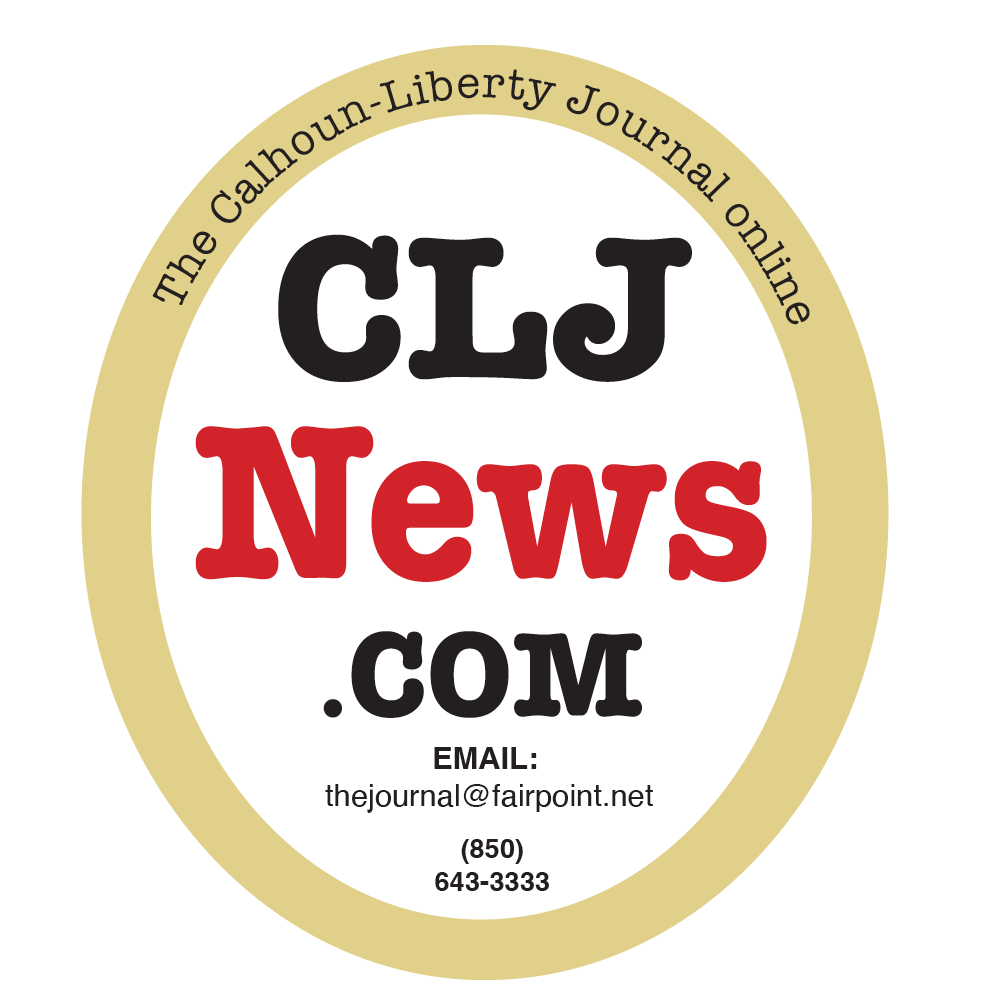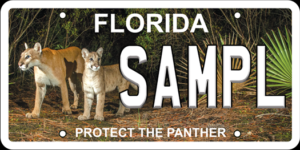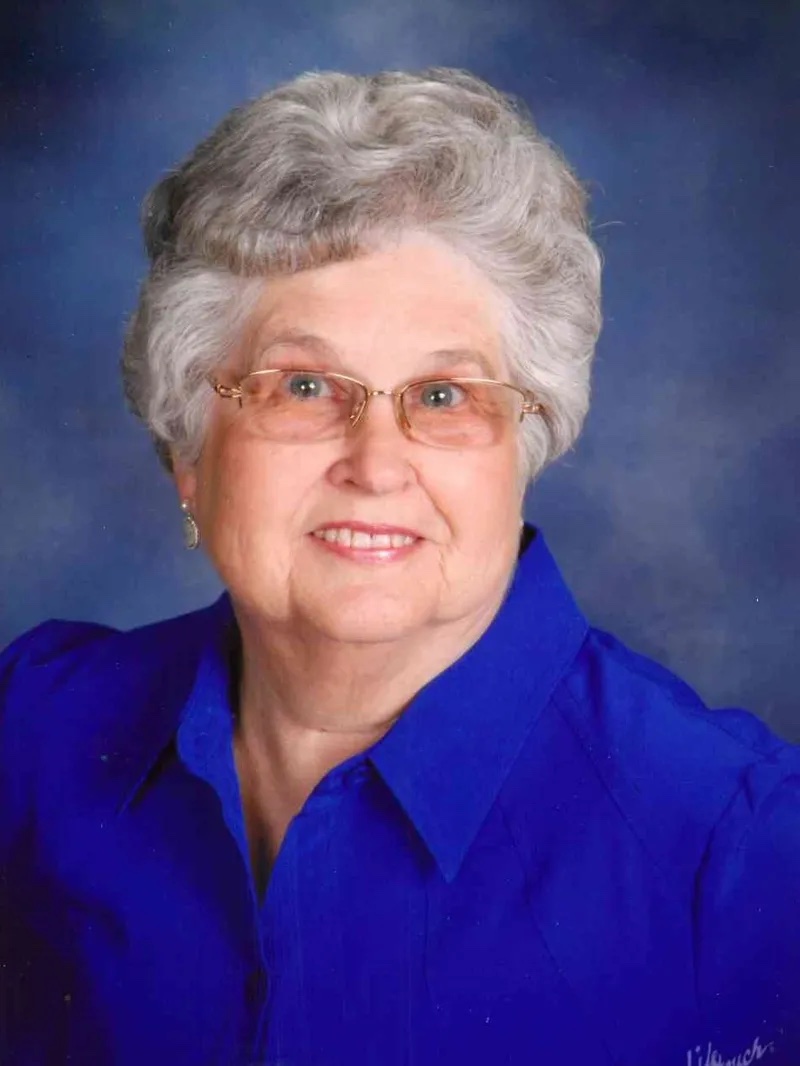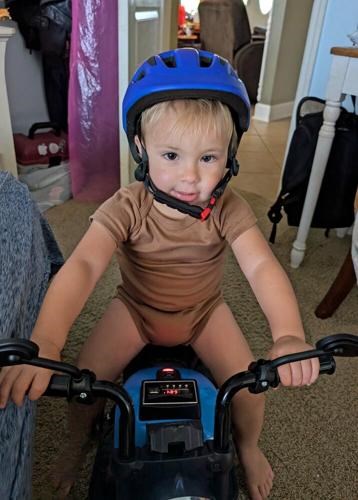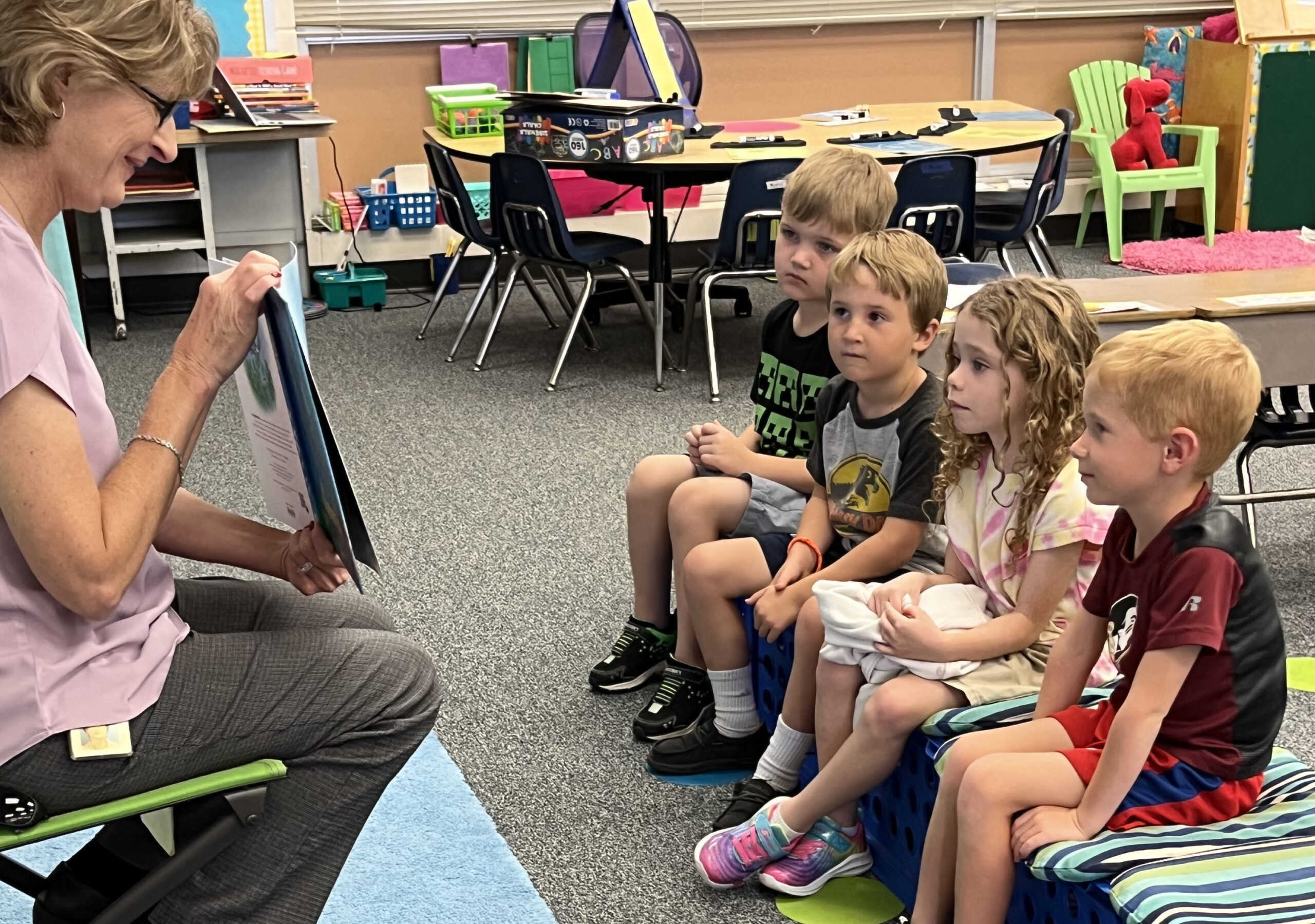OUTDOORS
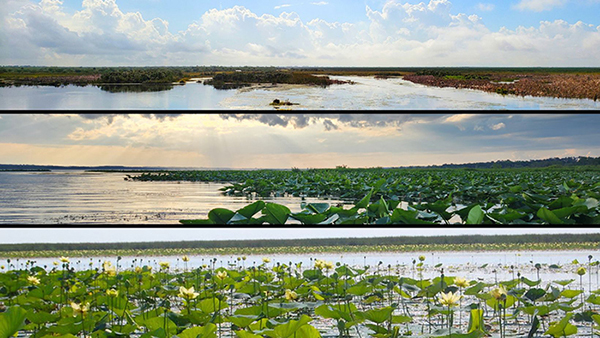
The FWC celebrates Florida waterbodies listed
in Bassmaster’s Top 10 Best Bass Lakes of 2023
The Florida Fish and Wildlife Conservation Commission (FWC) is thrilled to announce and celebrate the inclusion of three remarkable Florida waterbodies in Bassmaster’s prestigious “Top 10 Best Bass Lakes of 2023.” Fellsmere Reservoir/Stick Marsh, Orange Lake and Lake Okeechobee have captured the attention of anglers and fishing enthusiasts across the nation, solidifying Florida’s reputation as a premier bass fishing destination. Additionally, Florida lakes made a good showing in the Best Bass Lakes 2023: Southeastern as Fellsmere Reservoir, Orange Lake, Lake Okeechobee, Lake Toho, Lake Seminole (Jackson/Gadsden counties), Lake Placid, Lake Panasoffkee, Lake Istokpoga and Lake Rousseau are all featured on the list.
Bassmaster’s annual rankings are highly regarded within the angling community and serve as a testament to the incredible fishing opportunities available in the Sunshine State.
“We take a tremendous amount of pride in managing our freshwater fisheries. The recognition of multiple Florida waterbodies in the Best Bass Lakes is a testament to our commitment to preserve the well-being of our aquatic ecosystems while promoting recreational fishing in Florida,” said Roger Young, FWC Executive Director.
Fellsmere, Stick Marsh and Kenansville reservoirs, in Indian River County, are all gems for bass fishing enthusiasts. The FWC made major habitat improvements to Fellsmere Reservoir prior to creation of the reservoir and the Stick Marsh is currently undergoing a large-scale habitat enhancement project by FWC and partners. The FWC recognizes the significance of these resources and remains dedicated to sustainable fishing opportunities for future generations.
Orange Lake, in Alachua and Marion counties, has long been recognized as a hotspot for bass fishing. Its fertile waters and diverse habitat provide an ideal environment for largemouth bass, making it a favorite among local and visiting anglers. The FWC continues to work closely with partners and stakeholders to enhance Orange Lake’s fisheries and maintain its standing as a premier fishing destination.
Last but certainly not least, Lake Okeechobee once again earned a place on Bassmaster’s prestigious list. As Florida’s largest lake, Lake Okeechobee has unparalleled bass fishing opportunities. The FWC is committed to managing this iconic waterbody, using science-based practices to maintain its ecological balance and ensure a legendary fishing experience.
To maximize the enjoyment of these outstanding bass fishing destinations, the FWC encourages all anglers to familiarize themselves with local fishing regulations, including bag and size limits, licensing requirements, and any specific guidelines pertaining to each waterbody. Anglers looking to document their catch of a trophy bass; win prizes, including an annual free boat drawing; and contribute to fisheries research, should register for TrophyCatch, the FWC’s bass fishing angler recognition and citizen science program.
For more information on Florida’s freshwater fishing opportunities and the FWC’s conservation efforts, visit MyFWC.com/Freshwater.
______________________________________________________________________________________________________________________________________________________

FWC removes nearly 100 impaired operators during
Operation Dry Water and the Fourth of July holiday
In their 15th year participating in Operation Dry Water, Florida Fish and Wildlife Conservation Commission (FWC) officers spent their holiday weekend focused on the safety of people enjoying all that Florida’s waterways have to offer.
From July 1 through July 3, FWC officers arrested 94 vessel operators for boating under the influence of alcohol or drugs, preventing the possibility of life-altering events from occurring.
“Tragic accidents occur when irresponsibility is present,” said Col. Brian Smith, Director of FWC’s Division of Law Enforcement. “Operating a vessel while impaired puts the vessel operator, everyone on board and everyone around them in danger. I have no doubt that the hard work our officers and partner agencies put in over the holiday weekend saved lives.”
Operating a vessel while under the influence of alcohol or drugs is illegal on all bodies of water and can lead to serious injuries and consequences. In Florida, it is illegal to operate a vessel with a blood alcohol content of .08 or higher, the same as in a vehicle.
The FWC reminds boaters to enjoy the Florida sunshine and designate an operator that will remain sober to ensure the safety of everyone with them and around them plus encourages boaters to wear a life jacket and take a boating education course.
For more information about boating safety visit MyFWC.com/Boating.
______________________________________________________________________________________________________________________________________________________
Find a fawn? If you care, leave it there
White-tailed deer fawning can last many months in the Florida Panhandle. Sometimes people assume a fawn they find by itself has been abandoned and they try to “rescue” it. But instead of trying to rescue it, the Florida Fish and Wildlife Conservation Commission (FWC) advises that you leave it alone.
During the first few weeks of a fawn’s life, a doe will hide her offspring then move to a safe distance to prevent her scent from attracting predators to the young animal’s hiding spot. She’ll return often to nurse and care for the fawn. While hidden, the baby deer might lie motionless as a survival mechanism to deter predators. But sometimes people mistakenly think a fawn’s lack of movement means it’s sick or injured, prompting them to remove the animal to get it help.
If you find a fawn that you think is abandoned, do not touch it, pick it up or remove it from its natural environment. Instead, leave it alone and quietly move away from the area. If you come across a fawn and need additional direction, you can contact the appropriate FWC Regional Office for assistance.
With the detection of Chronic Wasting Disease (CWD) in Florida, The FWC has instituted new management actions within a defined zone to limit the spread of the disease. The rehabilitation of deer within that zone is prohibited by a new executive order.
For more information about deer in Florida, visit MyFWC.com/wildlifehabitats and under “Learn More about Florida Wildlife” click “Species Profiles” click “White-Tailed Deer.
Additional information on what to do if you find what appears to be injured or orphaned wildlife can be found at MyFWC.com/conservation and clicking “How You Can Conserve” then “Living with Wildlife and Preventing Wildlife Conflicts” then “Injured and Orphaned Wildlife.”
______________________________________________________________________________________________________________________________________________________
FDACS and partner agencies activate chronic wasting disease
response plan after disease detected in Florida white-tailed deer
The Florida Fish and Wildlife Conservation Commission (FWC) has confirmed that a road-killed 4.5-year-old female white-tailed deer in Holmes County sampled during routine surveillance activities has tested positive for chronic wasting disease (CWD). It is the first known case of CWD in Florida, a contagious disease of the brain and central nervous system that is fatal to deer. The first case of CWD in North America was described in mule deer in Colorado in 1967. Florida is the most recent of 31 states to detect the disease, which also has been confirmed in four Canadian provinces, Finland, Norway, Sweden and South Korea.
The FWC and its agency partners take CWD very seriously and have implemented a comprehensive response plan. As part of the plan, the FWC will collect samples from specific established zones to further assess the spread of the disease. The results from this initial sampling effort will inform resource managers so they can react with appropriate management strategies.
The FWC has been monitoring free-ranging deer since 2002 to detect CWD. During that time, the FWC has tested approximately 17,500 hunter-killed, road-killed and sick or diseased deer for CWD. In FY 2020-2021 in addition to funds generated by hunting permits, $266,000 was appropriated by the Florida Legislature to prepare the state’s comprehensive response to prevent the spread of CWD.
“With the continued support of Governor DeSantis, the Florida Legislature and hunters across the state, we have taken significant steps to prevent the spread of CWD,” said FWC Executive Director Roger Young. “Working with FDACS and our other partners, I’m hopeful that our combined efforts will limit the effects this will have on Florida’s deer population and preserve our exceptional hunting opportunities for future generations statewide.”
“We take very seriously our responsibility to prevent, detect, and respond to animal health issues in Florida – all to safeguard our agriculture industry and our world-renowned wildlife and natural resources,” said FDACS Commissioner Wilton Simpson. “Ensuring the health of Florida’s deer population is a team effort, and we will continue to work diligently with our state and federal partners to respond.”
The FWC is asking anyone who sees a sick, abnormally thin deer or finds a deer dead from unknown causes to call the CWD hotline, 866-CWD-WATCH (866-293-9282) and report the animal’s location.
Currently, there is no scientific evidence that CWD can be transmitted to humans or livestock under natural conditions. However, the Centers for Disease Control and Prevention do not recommend consuming meat from animals that test positive for CWD or from any sick animal. The FWC provides information about precautions people should take when pursuing or handling deer that may have been exposed to CWD.
CWD is a contagious disease believed to be caused by an abnormal protein called a prion. It is a fatal disease for all members of the deer family and is currently documented in white-tailed deer, mule deer, sika deer, elk, moose and caribou. Signs of the disease usually appear 1.5 to 3 years after initial exposure and can include extreme weight loss and abnormal behaviors such as listlessness, lowering of the head, inattentiveness toward people, walking in circles, staggering and standing with a wide stance.
Controlling the spread of CWD is difficult once it becomes established in a natural population. Because prions shed by infected deer persist in the environment, the best chance for controlling CWD is acting quickly after it’s been detected to prevent more animals from becoming infected. CWD can be transmitted directly – from animal to animal – or indirectly from the environment. Multiple management strategies will be employed to control the spread of the disease.
The FWC along with its partners – the Florida Department of Agriculture and Consumer Services, U.S. Department of Agriculture, U.S. Fish and Wildlife Service, Florida Department of Health, the Centers for Disease Control and Prevention, and the Southeastern Cooperative Wildlife Disease Study – will continue to update the public as more information becomes available. For more information, visit MyFWC.com/CWD.
______________________________________________________________________________________________________________________________________________________

FWC announces winner of the School Fishing
Club Conservation Project Competition
The Florida Fish and Wildlife Conservation Commission’s (FWC) School Fishing Club Program congratulates the Chambers High School fishing team as the Grand Prize winners of FWC’s School Fishing Conservation Project Competition. The students completed six conservation projects, including cleaning up and building monofilament recycling bins for their local waterbodies.
All student anglers participating in the FWC’s 2022-23 School Fishing Club Program were required to complete at least one conservation project to qualify for funding associated with the program. Prizes from our partners were offered for the conservation project winners as incentives for student anglers to complete multiple conservation initiatives throughout the year. FWC’s Conservation Project Competition awarded points per club participation in a variety of conservation-minded activities aimed at reducing the impacts of plastic pollution.
“Congratulations to these young anglers for their dedication to conservation,” said Tom Graef, FWC’s Director for the Division of Freshwater Fisheries Management. “They are making a difference by leading the way for the next generation of anglers with these creative conservation projects.”
Chambers High School won the Grand Prize, a private in-person custom rod building class with Mud Hole Custom Tackle. Punta Gorda Middle School won the Second Place Prize, and A. Crawford Mosley High School won the Third Place Prize. Additional prizing for second and third place was provided by Toadfish and Pure Fishing.
“Supporting youth education is so important to our mission at Mud Hole Custom Tackle,” said Anthony Youmans, Mud Hole’s Education Program Director. “We’re honored to contribute the Grand Prize in this year’s competition and are always supportive of FWC’s efforts to lead conservation projects here in Florida, our home state.”
Mud Hole Custom Tackle, based in Oviedo, is the world’s largest supplier of rod building and tackle crafting goods and instruction. From rod building and repairing, to fly tying and lure building, Mud Hole is the leading e-retailer and mail order supplier to hobbyists, small manufacturers, and large OEMs, worldwide. Offering a superior shopping experience at mudhole.com, rapid fulfillment, stellar customer service, and world class online content and instruction, Mud Hole Custom Tackle is the trusted source for the rod building and tackle crafting community.
FWC’s School Fishing Club Program welcomed 38 new and 14 returning student angling clubs in Florida to the program in 2022, supported by the Division of Marine Fisheries Management, the Division of Freshwater Fisheries Management, and the Florida Youth Conservation Centers Network. The clubs committed to complete the provided FWC curriculum and at least one conservation project. Club mentors provided support and hands-on training in knot tying and fishing gear assembly, as well as assistance with the clubs’ local events to increase student anglers’ confidence in the sport of fishing.
Information about the 2023-24 School Fishing Club Program will be announced in the summer of 2023. For more information about the School Fishing Club Program, you can visit MyFWC.com/SFC.
______________________________________________________________________________________________________________________________________________________
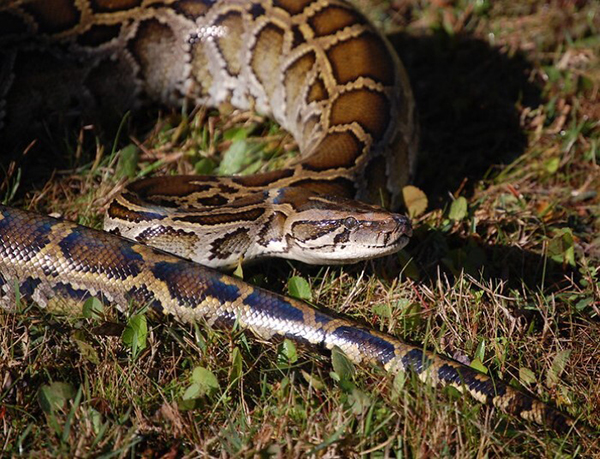
Thanks to sponsors, more than $30,000 up for
grabs at the 2023 Florida Python Challenge
Thanks to the generosity of sponsors, participants of the 2023 Florida Python Challenge have the opportunity to win a share of thousands in cash prizes. The event, which is hosted by the Florida Fish and Wildlife Conservation Commission (FWC) and the South Florida Water Management District (SFWMD), features an Ultimate Grand Prize of $10,000 sponsored by Inversa Leathers. There is also a prize of $7,500 for the Grand Prize Runner Up, sponsored by the Bergeron Everglades Foundation. “This year we’re going to have $30,000 worth of prizes,” said FWC Chairman Rodney Barreto. “We want to thank the private sector. Without them we couldn’t offer such great incentives.” Prizes will also be awarded in the professional, novice and military categories courtesy of Edison National Bank/Bank of the Islands and the Fish & Wildlife Foundation of Florida.
Under the leadership of Gov. Ron DeSantis, the FWC, SFWMD and the Fish & Wildlife Foundation of Florida host the Florida Python Challenge® to raise awareness about invasive species in Florida and their impacts.
The event, which runs Aug. 4 – 13, encourages people to get directly involved in Everglades conservation through invasive species removal. Visit FLPythonChallenge.org to register for the competition, take the required online training, view the optional training opportunities, learn more about Burmese pythons and the unique Everglades ecosystem, and find resources for planning your trip to south Florida to participate in the Florida Python Challenge.
______________________________________________________________________________________________________________________________________________________
Recreational harvest of gray triggerfish
closes in Gulf state waters on June 1
The recreational harvest of gray triggerfish in Gulf of Mexico state and federal waters closes June 1 and will remain closed through July 31, reopening from Aug. 1 to Dec. 31. Seasonal harvest closures help conserve Florida’s valuable gray triggerfish populations and improve these fisheries for the future.
______________________________________________________________________________________________________________________________________________________

FWC announces 2023’s Lionfish
Challenge presented by Zookeeper
Everyone’s favorite event of the year is back! The Florida Fish and Wildlife Conservation Commission (FWC) is excited to announce the 2023 Lionfish Challenge, sponsored by Zookeeper. As a Florida-based lionfish hunting gear and apparel outfitter, the Zookeeper team is aware of the negative impacts lionfish have caused and want to support the organizations and divers working to fight the lionfish invasion. This year’s tournament shirt was custom-designed and printed by Zookeeper and will be awarded to participants who reach the first prize tier.
The Lionfish Challenge is a free summer-long lionfish tournament open to recreational and commercial competitors of all ages around the state of Florida. There’ been an astounding number of lionfish removed as part of this challenge, more than 165,000. As we kick off the eighth year of the Lionfish Challenge, our goal remains the same: remove as many lionfish as we can in just four months.
Tournament details: Timeline: June 1 to Oct. 1.
Categories: Participants will compete in either the commercial or the recreational division with grand prizes to the top competitors in each division.
Military prize: We will be awarding an additional grand prize to the top Active Military/Veteran competitor.
The FWC is honored to offer this new prize category for the 2023 Lionfish Challenge.
Prizes will be awarded in tiers as follows:
- Tier 1 – Harvest 25 lionfish (recreational category) or 50 pounds of lionfish (commercial category).
- Tier 2 – Harvest 75 lionfish (recreational category) or 250 pounds of lionfish (commercial category).
- Tier 3 – Harvest 250 lionfish (recreational category) or 500 pounds of lionfish (commercial category).
- Tier 4 – Harvest 500 lionfish (recreational category) or 1,000 pounds of lionfish (commercial category).
To read the full tournament rules and register, visit FWCreefrangers.com/lionfish-challenge. Check out Zookeeper’s website at Lionfishzk.com.
______________________________________________________________________________________________________________________________________________________
FWC partners with RBFF to fund
youth fishing education in Florida
The Florida Fish and Wildlife Conservation Commission (FWC) and the Recreational Boating and Fishing Foundation (RBFF) have partnered again to fund youth fishing education through the Vamos A PescarTM (Let’s 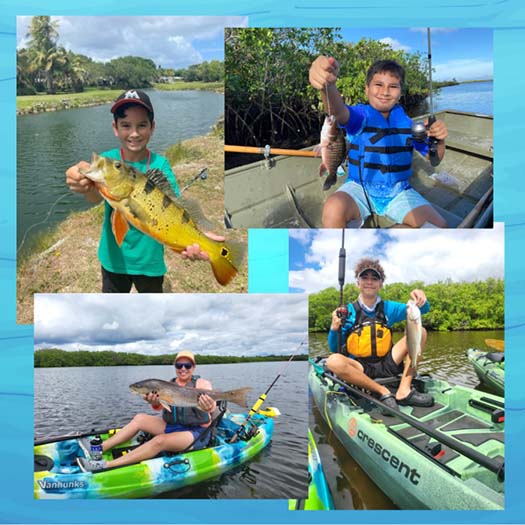
Go Fishing) initiative. The FWC and RBFF will support five organizations that help Florida’s Hispanic youth learn about conservation, fishing practices and fishing gear to create confident and responsible anglers. The George H.W. Bush Vamos A Pescar™ Education Fund provides funds for state agencies to match and then subgrant to local organizations to engage Hispanic families in fishing, boating and conservation activities. “Youth are the future of fisheries conservation,” said Tom Graef, FWC Division of Freshwater Fisheries Management Director. “The partnerships built through this grant program expand participation in outdoor recreation and fishing education and help us create the next generation that cares.”
The RBFF is a nonprofit organization established in 1998, whose mission is to increase participation in recreational angling and boating, thereby protecting and restoring the nation’s aquatic natural resources. The FWC began partnering with RBFF in 2016 on the Vamos a Pescar initiative and the program has grown over the years, funding a total of 14 community programs. The FWC is excited all five organizations were selected for funding in 2023, the most participants FWC has had in a single year. During the program, the partner organizations engage with local Hispanic communities to provide support and hands-on training in fishing basics through summer camps and fishing clinics.
Are you interested in working with FWC to support youth fishing education or other conservation programs? Contact your local Florida Youth Conservation Centers Network coordinator to learn how to qualify and join us on Kids and Conservation.
___________________________________________________________________________________________________________________________________________________
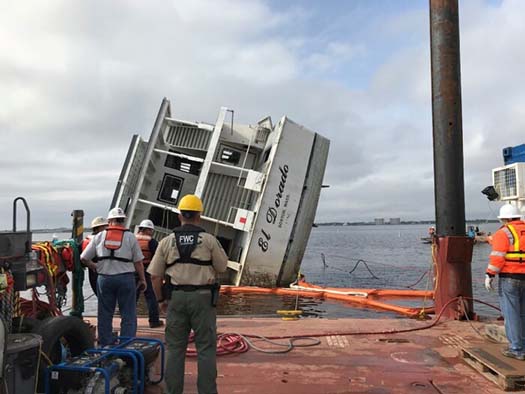
FWC to conduct restoration
project at Saint Andrew Bay
The Florida Fish and Wildlife Conservation Commission (FWC) will begin an aquatic habitat restoration effort within St. Andrew Bay’s North Bay in Bay County during the months of April and May. This project will restore seagrass habitat lost due to a vessel grounding event. FWC staff will first restore the grounding area to natural sediment grade followed by transplanting native seagrass.
The 147-foot commercial vessel M/V El Dorado was stranded in approximately two to three feet of water on a shallow seagrass bed in North Bay as a result of Hurricane Michael in Oct. 2018. The Hurricane Michael ESF-10 Unified Command (U.S. Coast Guard and FWC), recovered and removed the vessel from the site the following year. Bay County later turned this derelict vessel into an artificial reef 12 nautical miles off the shore of Panama City. The grounding site was left with a substantial depression devoid of seagrass. Beginning this month, FWC staff will return this depression to a natural grade by adding compatible sand to aid transplanting efforts and facilitate seagrass habitat recovery.
The FWC will plant approximately 1,400 native Cuban shoal grass planting units across .2 acres in May and then monitor plant survival to ensure the seagrass habitat recovers. Methods for this project will follow seagrass restoration techniques FWC staff successfully implemented with shoal grass in West Bay, St. Andrew Bay, in 2019 and 2021. Shoal grass is known as a seagrass pioneer species that grows quickly to stabilize the sediment for other species to colonize. This is the most common seagrass species in North Bay and will provide excellent habitat for local fish and wildlife, while providing sediment stabilization and improving water quality.
For more information regarding direct vessels and aquatic habitat restoration projects, visit MyFWC.com.
_____________________________________________________________________________________________________________________________________________________
FWC and Destin-Fort Walton Beach
to host 9thAnnual Lionfish Festival
The Florida Fish and Wildlife Conservation Commission and Destin-Fort Walton Beach will celebrate the ninth annual Lionfish Festival May 20 and May 21, 10 a.m. – 5 p.m. CT at AJ’s Seafood and Oyster Bar and HarborWalk Village in Destin. This outdoor event is free, open to the public and will feature family friendly activities, art, diving and marine conservation booths, live music, fillet demonstrations and the world’s largest lionfish tournament, the Emerald Coast Open.
The Emerald Coast Open will run May 19 and May 20 and include categories for most lionfish, largest lionfish and smallest lionfish with nearly $100,000 worth of prizes up for grabs! For official tournament rules and registration instructions, visit EmeraldCoastOpen.com.
Sample lionfish at one of Destin–Fort Walton Beach’s featured restaurants during the Emerald Coast Open Lionfish Restaurant Week. Local chefs will highlight lionfish in unique dishes in the week leading up to the event to help bring awareness to the lionfish invasion in the Gulf of Mexico.
The Boathouse Landing, Valparaiso – May 12
The Harbor Tavern – May 13
Dewey Destin’s Harborside – May 14
Crab Trap Destin – May 15
La Paz – May 16
Harbor Docks – May 17
Brotula’s Seafood House & Steamer – May 18
AJ’s Seafood & Oyster Bar– May 20.
To increase public awareness about the lionfish invasion and encourage removal efforts, the FWC signed a resolution creating Lionfish Removal and Awareness Day in Feb. 2015. LRAD is celebrated the first Saturday after Mother’s Day each year. The 2023 Lionfish Challenge is quickly approaching. This summer long tournament is open to everyone and is completely free to enter. Participants in last year’s Challenge reached a significant milestone of over 1 million lionfish harvested from Florida waters since the program began in 2014! Visit FWCReefRangers.com to register for the Lionfish Challenge. Contact the FWC Division of Marine Fisheries Management at (850) 487-0554.
______________________________________________________________________________________________________________________________________________________
Recreational regulation changes for Atlantic red porgy
Starting April 1 in Atlantic state waters, the red porgy recreational bag limit will reduce from three to one fish per person/day and the open recreational season will be May – June. As such, red porgy will be closed to recreational harvest in Atlantic state waters starting April 1 and will re-open on May 1.
FWC recently approved recreational management changes for red porgy and several other reef fish to be consistent with recent federal changes. Last year, the South Atlantic Fishery Management Council approved management changes to help rebuild the red porgy stock, which is overfished and undergoing overfishing. Consistent regulations between state and federal waters can help improve the red porgy fishery, increase regulatory compliance and aid in enforcement.
Learn more about recreational red porgy regulations by visiting MyFWC.com/Marine and selecting “Red Porgy” under the “Reef Fish”.
______________________________________________________________________________________________________________________________________________________
Go slow and look out below manatees are on the move
Spring is a particularly important season for boaters to go slow and lookout below for manatees as the slow moving mammals naturally disperse from their winter refuges, traveling to other parts of the state and beyond.
Manatees depend on water generally warmer than 68 degrees Fahrenheit to survive the winter, so in the fall, they travel to Florida springs, power plant discharges and other warm-water sites. In the spring, as water temperatures rise, manatees gradually leave their winter habitats and are more likely to be found in rivers, canals and nearshore waters. While manatees are large, they can be difficult to see in the water. That is why it is important to: go slow and follow all manatee protection zones; wear polarized glasses and look out below while boating or using personal watercraft — a visible snout or large circles on the water are indicators that manatees are below the surface; and always give manatees space. Manatee protection zones are marked by waterway signs and maps of manatee protection zones are available online at MyFWC.com/Manatee by clicking on “Data and Maps.” From April 1 through Nov. 15, seasonal manatee zones require boaters to slow down in certain areas to prevent manatees from being injured or killed by motorboats or personal watercrafts. Boat strikes continue to be a major threat to Florida manatees. FWC law enforcement officers are on patrol in state waters to inform boaters of the seasonal manatee speed zones and take appropriate enforcement actions. Boaters are reminded to abide by the regulatory signs they see on the water.
Manatees are a protected species and it is illegal to feed, harass or harm them. Physically handling a distressed or stranded manatee can cause additional harm. Instead, report injured, distressed, sick or dead manatees to the FWC’s Wildlife Alert Hotline at 888-404-FWCC (3922) so trained responders can assist.
The Florida Fish and Wildlife Conservation Commission (FWC) and the U.S. Fish and Wildlife Service continue to respond to the manatee Unusual Mortality Event along the Atlantic coast of Florida. The FWC and the Service take manatee conservation seriously by actively implementing science-based conservation measures that are making a difference for manatees and habitat. Go to MyFWC.com/Manatee to learn more about response efforts. What should you do if you see a manatee? The Viewing Guidelines page provides helpful tips on respectfully viewing manatees, additional guidelines for boat and personal watercraft operators, and information on what you can do to help these amazing aquatic mammals. ______________________________________________________________________________________________________________________________________________________
Tips to safely co-exist with alligators
Spring in FL. means balmy weather, blooming flowers and nesting birds are beginning to take place. Warmer temperatures also mean alligators are more active and visible. FWC recommends taking precautions while in or around the water and also provides its safety materials to include a video and infographic in Spanish.
While serious injuries caused by alligators are rare in FL., FWC offers the following tips on how to safely co-exist with them:
•Keep a safe distance if you see an alligator and never feed one. When fed, alligators can lose their natural wariness and instead learn to associate people with the availability of food.
•Swim only in designated swimming areas during daylight hours. Alligators are most active between dusk and dawn.
•Keep pets on a leash and away from the water’s edge and never let them swim in fresh or brackish water. Pets often resemble alligators’ natural prey.
Call the FWC’s Nuisance Alligator Hotline at 866-FWC-GATOR (866-392-4286) if you believe an alligator poses a threat to people, pets or property and FWC will dispatch a contracted nuisance alligator trapper to resolve the situation. FWC places the highest priority on public safety and administers a Statewide Nuisance Alligator Program (SNAP) to proactively address alligator threats in developed areas, while conserving alligators in areas where they naturally occur.
Find more resources about living with alligators and Spanish translation information tools at MyFWC.com/Alligator. The American alligator, Florida’s state reptile, is a conservation success story. Florida has a healthy and stable alligator population, which is estimated at 1.3 million alligators of every size.They are found in freshwater lakes, ponds, swamps and slow-moving rivers in all 67 counties in Florida. Learn more about alligators.
____________________________________________________________________________________________________________________________________________________

Florida’s FWC upcoming annual WildQuest event
Join FWC for Florida WildQuest 2023, residents and visitors are encouraged to grab their phones and go on a wild adventure to complete scavenger hunt missions and discover some of Florida’s best spots to see wildlife and enjoy the outdoors. This year’s event will take place on Florida’s Wildlife Management Areas across the state April 28 – May 7. Qualifying players will be entered in a random drawing to win wilderness inspired prizes by earning at least 2,000 points on one of the scavenger hunts, by following these steps:
1) Find It: Find your closest WildQuest WMA by visiting the Entrance Finder tool and looking for the areas marked by green dots.
2) Charge Up: Make sure your phone is charged and the Goosechase app is installed. Not all areas have mobile coverage but you’ll be able to take pictures for your scavenger hunt missions and submit them later. Visit com for instructions on how to join a WildQuest.
3) Be Safe: Stay on marked roads and trails. Before you enter a trail, be sure it fits your skill level and a distance you’re prepared for.
4) Pack Smart: It gets hot outside and there are no vending machines in the wilderness. Check the weather before you go. Pack water, sunscreen and snacks!
5) Snap a Pic: Most WMAs have a kiosk at the main entrance with a welcome sign that includes a map and important reminders for visiting the area. When you see this sign, be sure to take a picture for reference. Grab a guide at the kiosk if one is available.
Florida has one of the nation’s largest systems of state-managed wildlife lands. The WMA system includes more than 6 million acres managed primarily for wildlife conservation and nature-based public use. The areas featured in WildQuest will engage players in learning about Florida’s wildlife, habitats and recreation opportunities. The FWC maintains, enhances and restores native natural habitats for the benefit of plant and animal populations as well as for the people of Florida. To learn more about Florida’s WMA system, visit MyFWC.com/WMAs.
__________________________________________________________________________________________________________________________________________________
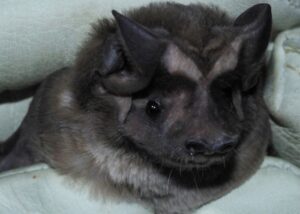
Exclusions should occur before
April bat maternity season starts
While Florida’s 13 native and beneficial bat species typically roost in trees, caves or other natural spaces, they can also be attracted to human made structures. The Florida Fish and Wildlife Conservation Commission (FWC) recommends property owners check homes and other buildings for roosting bats before maternity season starts.
April 15 marks the start of bat maternity season and is the last day to legally exclude bats from your home or building. Bat maternity season, the time when bats give birth and raise their young, runs through Aug. 14. During that time, it is illegal to block bats from their roosts. If bats are excluded during maternity season, flightless young can be trapped inside the structure and die, which isn’t good for you or the bats. Now is the time to check your home for any entry points, ensure that no bats are present and make any necessary repairs. If bats are found, you should take steps to exclude them with a properly installed exclusion device before bat maternity season begins. It is only legal to exclude bats from Aug. 15 through April 15. Exclusion devices, which allow bats to safely exit a structure but block them from returning to roosts, are the only legal and most effective method to remove bats from your home or building. It is illegal in Florida to kill or harm bats, so exclusion guidelines were developed to ensure bats are excluded safely and effectively from buildings outside of maternity season. Bat exclusion is a multi-step process that begins by identifying all potential bat entry and exit points in a building. To legally exclude bats, exclusion devices must be installed on key exit points, left up for a minimum of four nights and the exclusion must be conducted when the overnight temperature is forecast to be 50ºFor above.
Bats are beneficial, both ecologically and economically. They serve critical functions worldwide due to their roles in insect pest control and as pollinators and seed dispersers, plus their guano can be a valuable fertilizer. Florida’s bats are insectivores and a single bat can eat hundreds of insects, including mosquitoes and other garden and agricultural pests, each night. Florida’s native bat populations include threatened species including the Florida bonneted bat. Want to help our bats? There are several ways that Florida residents and visitors can support bat conservation:
•Preserve natural roost sites, including trees with cavities or peeling bark.
•Leave dead fronds on palm trees to provide roosting spots for bats.
•Install a bat house on your property.
•Report unusual bat behavior, as well as sick or dead bats: MyFWC.com/BatMortality.
For more information about how to properly exclude bats as well as other tips to bat-proof your home, visit MyFWC.com/Bats. and click “Bats in Buildings.”
____________________________________________________________________________________________________________________________________________________
New funding available for USDA Conservation Stewardship Program
through Inflation Reduction Act
GAINESVILLE – The U.S. Department of Agriculture’s Natural Resources Conservation Service is accepting applications to its Conservation Stewardship Program for funding in Fiscal Year 2023 using funds provided by the Inflation Reduction Act. Applications will be accepted until March 24 and are available at your local USDA Services Center or online at Get Started with NRCS web page. Due to this, CSP Classic applications batching period will also be extended from Feb. 24 to March 24, so both signups finalize at the same time. All applications received after this date will be considered for a future funding cycle. CSP-IRA applications must include at least one core Climate Smart Agriculture and Forestry conservation practice or activity that directly improves soil carbon, reduces nitrogen losses, or reduces, captures, avoids or sequesters carbon dioxide, methane or nitrous emissions associated with agricultural productions. Facilitating practices or activities that are needed to implement the core practice may also be included.
Florida NRCS’ CSP-IRA focus for Fiscal Year 2023 will include, but is not limited to:
•Improving energy efficiency of stationary equipment and facilities on agriculture operations to reduce energy use.
•Increasing total carbon stored in soils and/or perennial biomass to reduce atmospheric concentrations of carbon dioxide and enhance carbon sequestration.
Additionally, farm records must be established or updated with the Farm Service Agency for both the person(s) and the land for your application to be eligible and evaluated. Farm records for the person must indicate the applicant:
•Controls or owns eligible land
• Is in compliance with highly erodible land and wetland conservation requirements
•Meets adjusted gross income and payment limitation provisions
“If you are already taking steps to improve the condition of the land then chances are, CSP can help you find new ways to meet your goals,” said Juan C. Hernandez, State Conservationist for NRCS in Florida. “CSP offers annual payments for implementing conservation practices on your land and operating and maintaining existing conservation efforts.” The CSP is for working lands and is the largest conservation program in the U.S. Thousands of people voluntarily enroll in the program, because it helps them enhance natural resources and improve their business operation. The program represents a genuine commitment to conservation. CSP contracts are for five years, with the opportunity to compete for a contract renewal if the landowner successfully fulfills the initial contract and agrees to achieve additional conservation objectives. Once an application has been filed and determined to be eligible for CSP, the local NRCS conservation planner will have a one-on-one consultation with the applicant to evaluate the concerns for the land or natural resource conditions. An NRCS conservation planner will present conservation practices or enhancements to improve and protect these natural resources and will work closely with the landowner throughout the entire contract process.
Contract payments are based on two components:
•Payments to maintain the existing level of conservation, based on the land uses included in the contract and an NRCS assessment of existing stewardship at the time of enrollment
•Payments to implement additional conservation activities
More on NRCS
NRCS has 34 field offices throughout Florida with teams ready to help landowners with conservation programs. Contact your local NRCS field office for more information. Download an CSP application form.
More on IRA
The Inflation Reduction Act (IRA), provisions of which are designed to help agricultural producers continue to farm and to promote climate-smart agriculture by increasing farmers’ access to conservation services, was signed into law on Aug. 16, 2022.
Visit https://www.nrcs.usda.gov/conservation-basics/conservation-by-state/florida/news/new-funding-available-for-usda-conservation for more information.
_______________________________________________________________________________________________________________________________________________________
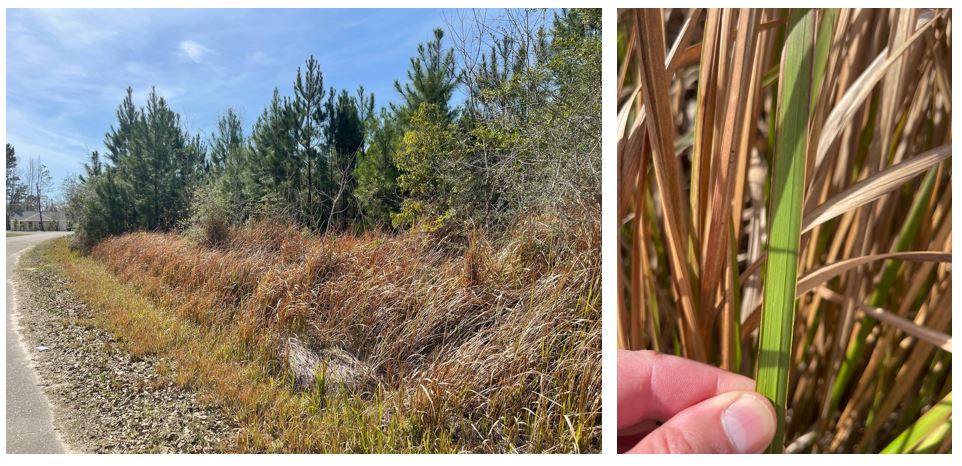
NISAW: A spreading menace is in
Gulf County, known as Cogongrass
by Ray Bodrey, Gulf County Extension Director
Cogongrass continues to be a thorn in the side of many landowners and municipal public works departments, as it spreads in areas across the Panhandle, with Gulf County being no exception. Thankfully, there are ways to combat cogongrass, but it seems to be an uphill battle. Identifying and being persistent with treatment are paramount in control.
Cogongrass (Imperata cylindrica) is found all over the world but in the U.S, it is primarily found in the southeast. Cogongrass was purposely introduced as a soil stabilizer for pasture lands in Florida during the 1930s and 1940s. It wasn’t long before ranchers and agricultural scientists realized that cogongrass was an invasive species. Once established, cogongrass has the ability to overrun pastures and natural areas to the point that it will be the only plant species occupant. It’s a perennial grass with a vast, ever expanding root system. This grass can grow in any soil type and low soil fertility nor drought, are concerns either. Therefore, it thrives no matter how poor the soil environment. Even with multiple days of periods of well below freezing temperatures and a prior application of herbicide, cogongrass remains resilient. The major concern is the ability to eliminate native plant habitat.
Cogongrass can be confused with other grasses, like switchgrass. This is especially possible early in the year before the bloom.
To identify cogongrass, first investigate the growing pattern. It usually infiltrates an area in patches. The grass blades are flat and have a defining white mid-rib. Blades are finely serrated, yellow to green in color and are uneven in width on each side of the mid-rib. The seed head is fluffy, white and feather shaped. The seed head can alarmingly yield 3,000 seeds per head.
The management strategy most successful with eradicating cogongrass consists of multiple types of herbicides sprayed over multiple year applications, with additional spot treatments. Prescribe burning can also be used in concert as an integrated approach.
_____________________________________________________________________________
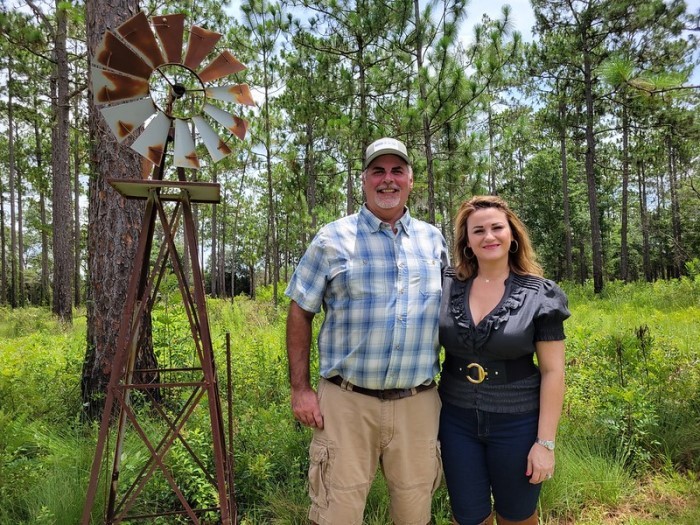
Landowners Danna and Stephen Matheny show their award winning acres.
Madison Co. landowners recognized
for excellence in land management
The Florida Fish and Wildlife Conservation Commission recognized landowners Danna and Stephen Matheny with the Florida Land Steward 2023 Landowner of the Year award. The couple was honored for their outstanding efforts to manage their 90 acres of pasture, planted longleaf and natural longleaf forest in Madison County.
The Matheny’s property, which has been in the family for generations, is primarily longleaf pine habitat that supports native plants and a variety of wildlife including gopher tortoises, bobwhite quails, pileated woodpeckers, bluebirds, foxes and many other species.
Working with the Florida Forest Service, the FWC, U.S. Fish and Wildlife Service and Natural Resources Conservation Service, the Matheny’s goal is restoring the upland habitat on the property. They continue to implement their Forest Stewardship Plan for the property and have been recognized by the FWC’s Wildlife Habitat Recognition Program for their efforts to manage the land to benefit native wildlife.
Stephen Matheny conducts a variety of land management activities including prescribed burns, hardwood control, selective harvest of mature pine and mowing, most of which he does on his own.“I recall my grandfather teaching me when I was young, to leave some dead trees standing for the woodpeckers, flying squirrels and bluebirds. I want my children to appreciate the importance of all the different species that depend on this habitat to survive,” said Stephen Matheny. “I hope they continue what I have taught them and are good stewards of the property for years to come.”
The Florida Land Steward program is a partnership that focuses resources available to private landowners conserving their lands for wildlife, with partners that include the FWC, Florida Forest Service, University of Florida Institute of Food and Agricultural Sciences, USDA Natural Resources Conservation Service and the U.S. Fish and Wildlife Service. To show support for Florida’s private landowners, the Florida Land Steward Partnership annually recognizes the “Landowner of the Year,” a private landowner who goes above and beyond managing their property with highly commendable land stewardship.
Learn how the FWC partners with private landowners at MyFWC.com/LAP. Find out about workshops and other resources for private landowners at FloridaLandSteward.org.
_____________________________________________________________________________
FWC taking bold steps to prevent
new invasive species in Florida
Commissioners with the Florida Fish and Wildlife Conservation Commission directed staff to take bold steps to protect Florida’s native ecosystems from invasive fish and wildlife. During the meeting in Feb., Commissioners tasked staff with drafting proposed rules to prevent the establishment of new non-native species in Florida. Staff will explore including a risk analysis to prove a species poses little or no threat to Florida’s ecology, economy, as well as human health and safety, before that species could be approved to come into the state.
“I have no qualms about saying we are shutting Florida down to invasive species. You are going to have to prove to us that what you are bringing in is not hurting Florida, that it will not harm our native ecosystem,” said FWC Chairman Rodney Barreto. “Look what the Burmese python and the tegu have done already. We are not trying to hurt the industry, but the time has come that we say Florida is off limits to any new species.” Staff will share any proposal with the Non-native Fish and Wildlife Technical Assistance Group, also known as the TAG and will solicit feedback.
Florida is highly susceptible to the successful establishment of non-native and invasive fish and wildlife due to the subtropical climate, multiple ports of entry and the high levels of live animal trade. Non-native fish and wildlife can cause harm to Florida’s ecology and economy as well as human health and safety. More than 500 non-native species have been reported in FL. A substantial amount of these have been introduced via the live animal trade with at least 139 established in Florida, meaning they are reproducing in the wild. Since most non-native fish and wildlife find their way into Florida’s habitats through escape or release from the live animal trade, it is important to prevent high risk non-native fish and wildlife from becoming introduced or further established in Florida’s environment through regulatory action.
The FWC uses regulation of high risk non-native fish and wildlife in conjunction with a variety of other management strategies to minimize adverse impacts of invasive species and to prevent the introduction of additional species into the wild.
For more information about non-native species in Florida, visit MyFWC.com/Nonnatives.
FWC’s Catch a Florida Memory program: fishing for sport, prizes and conservation
With over 4,000 participating anglers and 36 sponsoring partners, Catch a Florida Memory is the Florida Fish and Wildlife Conservation Commission’s exciting and engaging saltwater angler recognition program.
This program encourages participants to learn more about Florida’s vast recreational fishing opportunities and an angler’s role in marine conservation by enticing them to target a variety of saltwater species and rewards them with prizes for submitting photos of their catches. Launched in 2016, Catch a Florida Memory has received more than 27,500 saltwater fish photo submissions from participants of all experience levels and ranging in ages from 3 years old to 90 years old.
Anglers can earn recognition in five different ways:
•Life List: a list of 70 different species of saltwater fish to challenge an angler to catch over their lifetime.
•Reel Big Fish: recognizes anglers for catches that meet or exceed a minimum length for 30 different saltwater species.
•Grand Slams: nine different slams that challenge anglers to catch three specified fish species in a 24-hour period
•Triple Threat Club: anglers are awarded this status when they have caught a Grand Slam, a Reel Big Fish and have qualified for at least the Life List 10-Fish Club.
•Florida Saltwater Fishing Records: state records are for the heaviest marine fishes caught in Florida waters or in federal waters extending directly outward of Florida state line boundaries, and are maintained for 81 species in all-tackle and fly-fishing categories.
This year, the program is expanding to host the very first Triple Threat Throwdown raffle challenge that will reward one lucky angler with a fully outfitted fishing kayak, sponsored by Bonafide and Yakattack and valued at over $2,000.
“Continuing to grow this community of engaged anglers who are passionate about Florida’s saltwater fish and marine ecosystems is vital to our mission of conservation and management,” said Jessica McCawley, Director of Marine Fisheries Management. “Thanks to the support of our incredible partners and the commitment of our Catch a Florida Memory anglers, our program is a success and continues to grow each year.” Visit CatchaFLMemory.com and click on “Additional Raffle Details.” to learn more about the Triple Threat Throwdown or contact Angler.Recogntion@MyFWC.com or (850) 487-0554.
FWC approves new rule to help
improve survival of released reef fish
At its Feb. 22 meeting, the Florida Fish and Wildlife Conservation Commission approved a rule to require the possession of a descending device or venting tool that is rigged and ready for use on board a vessel when harvesting or attempting to harvest, including catch and release, of reef fish in state waters.This rule will also require the use a descending device or venting tool if a fish is exhibiting signs of barotrauma prior to release.
This rule is designed to increase the survival of released reef fish, a top priority management issue in the Gulf and South Atlantic. As reef fish are reeled up from depth, they can suffer pressure-related injuries known as barotrauma. These injuries include the stomach protruding out of the mouth, bulging eyes, bloated belly, distended intestines and inability to swim down independently. If not treated correctly, barotrauma can be lethal to reef fish. Tools such as descending devices or venting tools can help released fish recover from the effects of barotrauma. Descending devices are weighted devices capable of releasing fish at a depth that is sufficient to recompress expanded gas and help fish recover from the effects of barotrauma. Venting tools are sharp, hollow instruments that allow expanded gas to escape from an over expanded swim bladder.
Barotrauma mitigation tool requirements have already been adopted in Gulf and Atlantic federal waters. In Gulf federal waters, fishers have the choice of possessing either a descending device or a venting tool that is rigged and ready for use. In Atlantic federal waters, fishers are required to have a descending device that is readily available for use.
Visit MyFWC.com to learn more about barotrauma to find current reef fish gear requirements. Anyone who plans to harvest or attempt to harvest, including catch and release, certain reef fish species in Gulf or Atlantic waters from a private recreational vessel (includes anglers over 65 years of age), must sign up for the free State Reef Fish Angler designation and renew it annually by going to GoOutdoorsFlorida.com.
![]()
